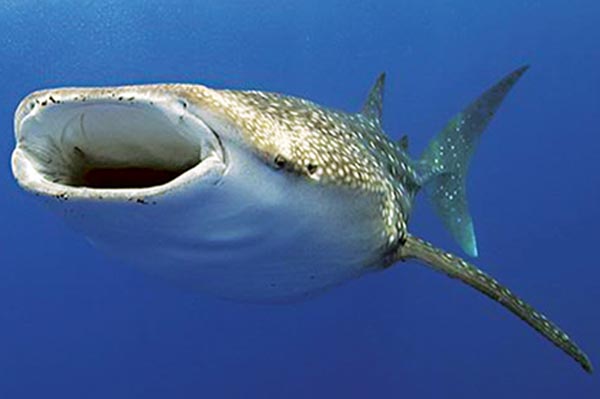No more butanding? Blame global warming
DONSOL, Sorsogon— They are sorely missed. Rising sea temperature due to climate change, stress and lack of food are keeping the whale shark, locally know as butanding, far from the coastal waters of this town and causing them to linger in other areas where plankton is abundant, a butanding interaction officer (BIO) said.
Alan Amanse, chair of the BIO Board of Donsol, said sightings of butanding in waters here have dropped from eight last year to only two in the first half of this year, endangering the tourism industry of the town.
Amanse said sea temperature has significantly increased from 26-27 degree Celsius last year to 29-30 degree Celsius this year.
There are currently only two whale sharks swimming off Donsol waters. They are “Curly,” which has a curly dorsal fin, and “Lucky,” which has a nylon cord tied to its tail.
“The bigger ones measuring 14 meters long are nowhere in sight,” said Amanse.
He said gone are the likes of the famous “Putol,” which has no caudal or tail fin, and “Nognog,” thus named for its dark color.
Amanse said the butanding are also suffering from stress because of the many interaction events conducted by the BIO during the butanding season from December to May.
He said there are at least 40 boats with six tourists each on board interacting with whale sharks in every event.
Town councilor Rey Aquino said the rampant harvesting of plankton by fishermen and the presence of E. coli contamination in the Donsol River due to the presence of household toilets along riverbanks further contributed to the scarcity of food in the feeding grounds of the butanding.
Amanse said the tourism industry of the town is hurting, losing millions of pesos in revenue. He said tourist arrivals dropped by 2,000 during the first half of this year, or close to 10 percent, from an average of 25,000 since 2007.
Amabel de la Cruz, Donsol Tourism Council revenue collector, in an interview, said the town’s tourist arrivals translated into some P4 million in revenues in 2012.
She said revenue collection for the past six months of this year reached only P2 million. De la Cruz, however, said she hoped revenues this year will match last year’s.
Another environment issue confronting Donsol is the cutting of mangrove trees in Barangay Ogod by residents who use these as a parking area for boats.
Aside from being tagged as the butanding capital of the country, Donsol has other tourist attractions like the “Firefly Watch” in Ogod River and an 800-square-kilometer fish sanctuary near the coastal villages of Sibago, Tinanogan and San Rafael.
Donsol town is a third class town in Sorsogon with a population of over 47,000.
Eastern Visayas tourism earns P2 billion
TACLOBAN CITY—The tourism industry in Eastern Visayas generated over P2 billion in income for the region.
Karina Rosa Tiopes, Department of Tourism regional director for Eastern Visayas, said the P2.1 billion in tourism receipts indicated that Eastern Visayas is becoming a prime engine of growth for the region’s economy.
Last year, at least 490,470 tourists visited the region, according to Tiopes.
However, the growth in the region’s tourism industry is largely driven by domestic tourists.
Of the 490,472 tourists who visited the region last year, only 28,790 were foreigners, mostly Americans, Japanese, Europeans, Australians and Koreans, Tiopes said.
“Our tourism industry, just like in the rest of the country, remains to be a domestic-driven industry,” she said.
Tiopes said that the construction of new hotels, particularly in Tacloban which is the regional center and jump off point for tourists, indicated that positive things are happening in the tourism industry.
“They will not invest if our tourism industry is not doing well. These are businessmen who will not spend millions of pesos if they do not see any return of investments,” she added.
This year, the region is targetting more than half a million tourists.
Aside from Tacloban, tourists usually visit diving sites in Southern Leyte and the white sand beaches in Kalanggaman in Palompon and in Canigao, Matalom.
Hundred Islands cleanup begins
ALAMINOS CITY — Mayor Arthur Celeste on Saturday began dismantling illegally built structures at the Hundred Islands National Park here, saying these were “eyesores.”
“These are destroying the natural beauty of the islands. Besides, these facilities were poorly built,” said Celeste, who led the city government crew during the demolition.
The makeshift structures, which consist mostly of beach sheds rented out to tourists, were built on Quezon, Governor’s and Children’s islands, the park’s main tourist destinations.
“This is embarrassing to visitors. If I were a tourist here, I will not recommend that we return here,” Celeste said.
The defunct Philippine Tourism Authority turned over the management of the park, which consists of 123 islands, to the city government in 2005.
Celeste said that after cleaning the islands of the makeshift sheds, the city will build “more decent and presentable” structures for tourists’ use.
“I was able to secure P6 million for the construction of gazebos and pavilions on the islands,” Celeste said.
He said by December, potable water will be available on the three major islands frequented by visitors.
“And who knows, by then, we may already have a solar panel to supply electricity on Governor’s Island?” Celeste said.
Governor’s Island has a structure for overnight accommodation but its electricity is powered by a noisy generator that disturbs guests. Water supply is transported to the guest house by boats.
Bone Collector Museum joins MinTTE 2013
DAVAO CITY — THE Bone Collector Museum of Davao City is joining the 7th annual Mindanao Travel and Tour Expo (MinTTE) slated on August 9-11 at the Atrium of the Gaisano Mall of Davao.
“We need to support this kind of event to help promote tourism in Davao,” said Darryl Blatchley of Bone Collector Museum Inc. located at Barangay 20-B (at the back of Almendras gym).
Blatchley, an American bone collector married to a Dabawenya, said he will display mammals as big as the whale shark in the three-day expo organized by the Dabaw Tourism Operators Association (Dabtoa) and presented by AirAsia in coordination with the Department of Trade and Industry (DTI).
“We want to teach adults and kids alike about the amazing wildlife about the amazing wildlife around them in the world,” Blatchley said.
Bone Collector, an education center about animals, retrieves dead animals and preserve them for display at its museum.
“We want to teach what amazing animals God has given them to enjoy and protect” said Blatchley.
Bone Collector has already been featured in the Jessica Soho GMA 7 best of 2010 and Vintage Collections, Born to be Wild 2010 and many newspaper publications in the past.
It is open Monday to Friday (10 a.m. to 5 p.m.) and Saturday (1 p.m. to 5 p.m.). Meanwhile, a zumba event for all aerobics and fitness buffs will also be held at 7 p.m. on Aug. 9 as part of the MinTTE.
Fitness guru Ma. Victoria “Vicky” Javier, the first Zumba-licensed instructor in Davao City and owner of one of Davao’s longest running fitness and aerobics gym — Beefit Gym & Aerobics — will spearhead the one-hour and a half event.
For more information, pls. contact Vicky (0922-8943192) or Tolits (0947-4155462).
Disclaimer: The comments uploaded on this site do not necessarily represent or reflect the views of management and owner of Bandera. We reserve the right to exclude comments that we deem to be inconsistent with our editorial standards.



